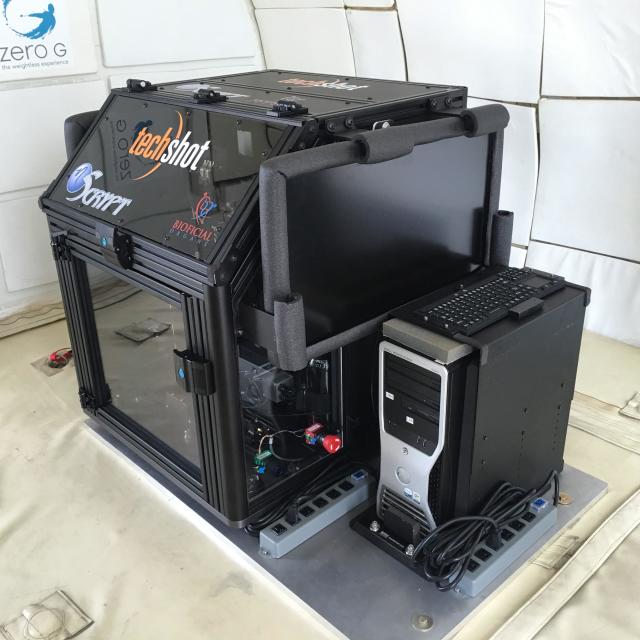Two high-tech companies have teamed up to develop a 3-D bio-printer capable of manufacturing human organs and tissues in orbit. The joint effort could result in the ability to manufacture transplantable organs in space for patients on earth, and help enable long-duration human exploration of deep space.
Techshot Inc., a technology developer firm, paired up with nScrypt, Inc., a manufacturer of industrial 3-D bio-printers, to conduct their experiment last June aboard a zero-gravity plane 30,000 feet over the Gulf of Mexico.
The test repeatedly produced several seconds of sustained microgravity in which the consortium’s prototype resulted in the first successful printing of cardiac and vascular structures in zero gravity with adult human stem cells.
“The hardware worked flawlessly,” says John Vellinger, vice president of Techshot, who was aboard the aircraft and helped operate the printer in weightlessness. “We’re eager to take the technology to the next level.”
Data from the flight will be used to design and construct a smaller and more robust bio-printer, which Vellinger hopes to see launched and operated autonomously aboard a commercial suborbital space capsule next January. A version designed for the International Space Station (ISS), capable of printing thicker, more complex tissues is expected to follow in 2018.
WHAT IS 3-D PRINTING?
Three-dimensional printing, also known as additive manufacturing, is the process of using additives to form solid three-dimensional (3-D) objects of virtually any shape from a digital model,
explains BCC Research analyst Andrew McWilliams.
“It’s achieved using specially formulated additives such as plastics that are formed into successive layers of material typically laid down on a platform in different shapes. Three-dimensional printing is uniquely distinct from a more traditional 3-D sculpting technique, which relies on the removal of layers, known as subtractive manufacturing, to produce a three-dimensional object.”
ADDITIVES AND BIO-INK
Additives are the materials used to form solid objects via 3-D printing. The additive material can be a liquid, powder or sheet material that is cured by heat, ultraviolet light, a chemical reaction or another method.
McWilliams
says that for simpler organs such as bladders, or cartilaginous structures such as ears or the trachea, 3-D bio-printing uses a “scaffold” designed in CAD and then 3-D printed to shape the organ, using a biocompatible material.
“A bio-ink made up of the organ’s cells or stem cells in the form of a hydrogel is then manually deposited to fill and cover the scaffold, which dissolves over time, leaving just the organic tissues,” he says. “The bio-ink is a hydrogel formed by different types of cells and distributed by multiple syringes. These are deposited, one on top of the other, in two-dimensional multicellular strips, forming the different combinations of cells and capillaries.”
In the case of more complex organs such as liver, heart or kidneys, which consist of many different cells, this method may not be appropriate. In such cases, cellular fabrics and scaffolds need to be printed directly and simultaneously in 3-D.
BIO-INK IN ZERO-GRAVITY APPLICATIONS
An important key to creating viable tissue in space is the ability to precisely place and buildup very fine layers of bio-ink. With the capability to print layers several times smaller than a human hair, professional-grade 3-D bioprinters and 3-D electronics printers from nScrypt feature the finest print tips made, some of which are nearly as small as a single human cell.
“On earth, 3-D bio-printing requires the use of thick bio-inks that can contain chemicals and other materials necessary to provide structural support,” said Techshot chief scientist Eugene Boland, who also was aboard the flight. “But printing tissues in space allows us to use finer print tips and lower viscosity bio-inks that contain only the biological materials needed to create a healthy organ. A space-based bio-printer has the potential to be a major game changer for human healthcare.”
Besides biological structures, the prototype device also printed electrically conductive and dielectric (insulative) material during the June airborne test. Organs and tissues printed later aboard the ISS will include built in pacing wires and biosensors. A beating human heart patch is expected to be the first tissue attempted aboard the station.
According to McWilliams, 3-D printed tissues are mostly used for medical research efforts like introducing disease to monitor how the tissue reacts and how future treatments may be developed. He notes that the printing of whole organs could be a reality within the next decade, assuming that regulatory authorities approve.




